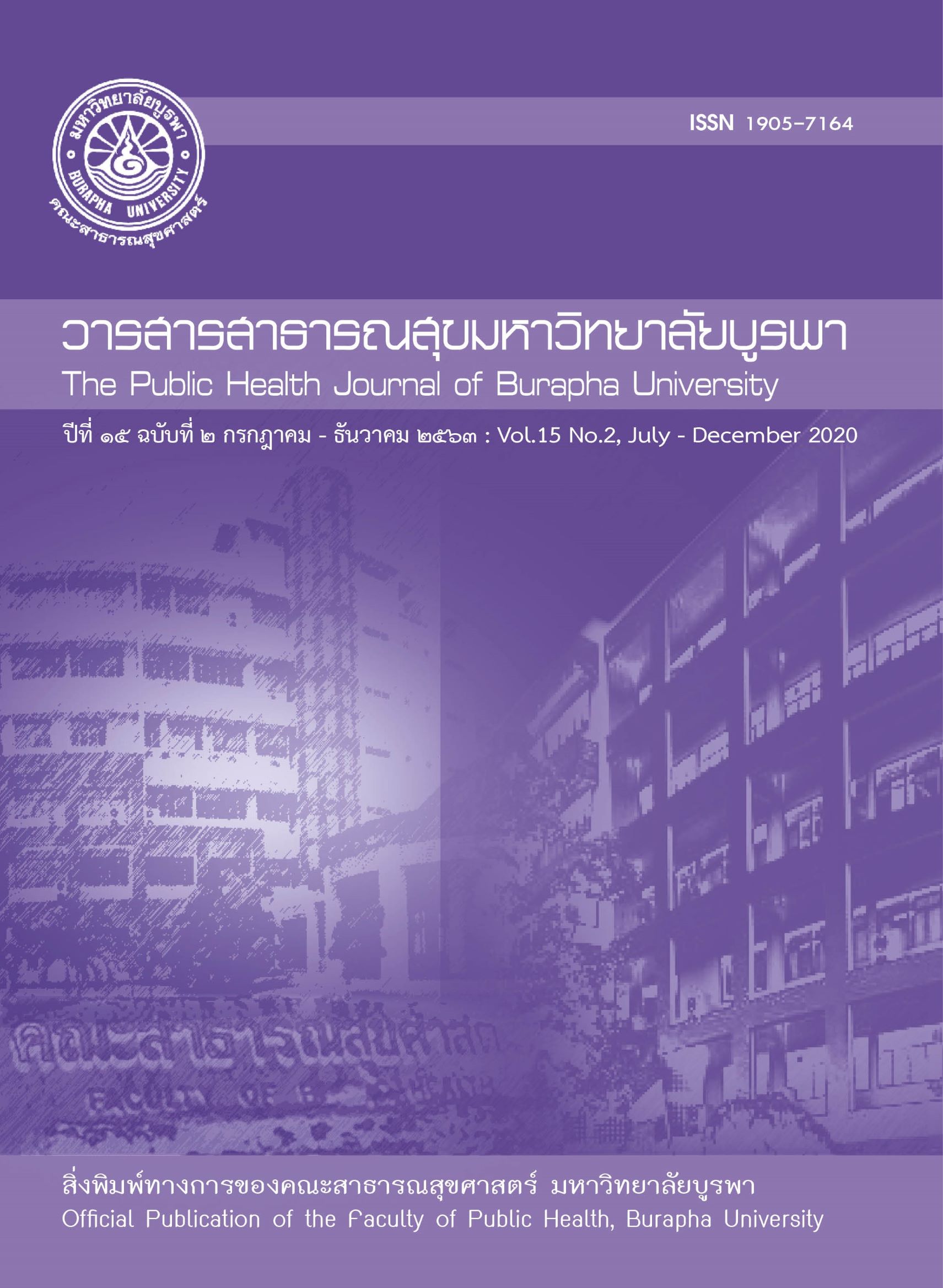การศึกษาการประเมินการรับสัมผัสสารโทลูอีนและอาการแสดงที่มีความสัมพันธ์กับความสามารถในการทำงานของพนักงานขับรถโดยสารธรรมดาในเขตกรุงเทพมหานคร
Main Article Content
บทคัดย่อ
The Evaluation of Toluene Exposure and Symptoms Related to Work Ability among Bus Drivers in Bangkok
งานวิจัยนี้เป็นการศึกษาแบบภาคตัดขวาง โดยมีการประเมินการรับสัมผัสสารโทลูอีนและอาการแสดงที่มีสัมพันธ์กับความสามารถในการทำงานของพนักงานขับรถโดยสารธรรมดาในเขตกรุงเทพมหานครโดยจำนวนตัวอย่างทั้งหมดในการศึกษามี 252 คน แบ่งเป็นกลุ่มศึกษา 152 คนและกลุ่มเปรียบเทียบ 100 คน กลุ่มศึกษามีอายุเฉลี่ย 44.16 ปี และ 41.52 ปี สำหรับกลุ่มเปรียบเทียบ กลุ่มศึกษามีสภาพการทำงานในแต่ละวันในหน้าที่หลักในการขับรถโดยสารธรรมดา 8 ชั่วโมงและ 10 ชั่วโมงต่อวัน ร้อยละ 69.8 และทำงาน 6 วันต่อสัปดาห์ ร้อยละ 98.7 มีการใช้อุปกรณ์ป้องกันระบบทางเดินหายใจทุกครั้งร้อยละ 13.8 โดยส่วนใหญ่มีการใช้ผ้าปิดจมูก ร้อยละ 74.8 และมีอาการแสดงหลังสิ้นสุดการทำงาน โดยพบว่า รู้สึกเมื่อยล้าเฉพาะแขนและขา (ร้อยละ 66.4) เมื่อยล้าทั่วร่างกาย (ร้อยละ 64.5) ปวดข้อเข่า (ร้อยละ 62.5) ไอ (ร้อยละ 53.3) ปวดศีรษะ (ร้อยละ 48.5) และ มึนงง (ร้อยละ 44.1) และพบว่ามีความสามารถในการทำงาน อยู่ในระดับดี ร้อยละ 62.5
ในการเก็บตัวอย่างอากาศใช้ Organic Vapor Monitor (3M 3500) ติดตัวบุคคลในระดับการหายใจของกลุ่มศึกษา พบว่า มีค่าเฉลี่ย (ส่วนเบี่ยงเบนมาตรฐาน) ของปริมาณความเข้มข้นของสารโทลูอีนในบรรยากาศการทำงานแบบติดตัวบุคคล 33.65 (8.39) ppb และสารโทลูอีนในปัสสาวะ 0.01 (0.01) mg/l และกลุ่มเปรียบเทียบมีค่าเฉลี่ย (ส่วนเบี่ยงเบนมาตรฐาน) ของปริมาณความเข้มข้นของสารโทลูอีนในบรรยากาศการทำงานแบบติดตัวบุคคล 0.02 (0.05) ppb และสารโทลูอีนในปัสสาวะ 0.20 (0.81) mg/l และระดับความสามารถในการทำงานของกลุ่มศึกษา (n = 152) ส่วนใหญ่อยู่ในระดับดี ร้อยละ 62.5 เมื่อเปรียบเทียบค่าเฉลี่ยของปริมาณความเข้มข้นของสารโทลูอีนในบรรยากาศการทำงานแบบติดตัวบุคคลและในปัสสาวะระหว่างกลุ่มศึกษาและกลุ่มเปรียบเทียบ พบว่ามีความแตกต่างกันอย่างมีนัยสำคัญทางสถิติที่ระดับ 0.01 และ 0.05 (p < 0.001, p=0.017 ตามลำดับ) และความสามารถในการทำงานและอาการแสดงระหว่างกลุ่มศึกษาและกลุ่มเปรียบเทียบ พบว่ามีความแตกต่างกันอย่างมีนัยสำคัญทางสถิติที่ระดับ 0.01 และ 0.05 (p<0.001 และ p =0.018 ตามลำดับ) และเมื่อหาความสัมพันธ์พบว่าปริมาณความเข้มข้นของสารโทลูอีนในบรรยากาศการทำงานแบบติดตัวบุคคลและในปัสสาวะกับความสามารถในการทำงาน พบว่าไม่มีความสัมพันธ์กัน แต่พบว่า อาการแสดงมีความสัมพันธ์กับความสามารถในการทำงานอย่างมีนัยสำคัญทางสถิติที่ระดับ 0.05 (p=0.034) จากผลการศึกษานี้ทำให้ตระหนักได้ว่ากลุ่มศึกษามีการสัมผัสสารโทลูอีนในขณะปฏิบัติงานและทางหน่วยงานควรให้ความสำคัญกับโปรแกรมการป้องกัน ควบคุมและส่งเสริมสุขภาพ รวมถึงการแนะนำให้ใช้อุปกรณ์ป้องกันระบบทางเดินหายใจที่ถูกต้องและเหมาะสมต่อไป
This research was a cross-sectional study. The objectives were to evaluate toluene exposure, symptoms and work ability among bus drivers in Bangkok. We sampled 252 persons; 152 cases who worked as bus drivers and 100 comparisons. The mean age of the study group was 44.16 years old, whereas 41.52 years old for the comparisons. Sixty-nine point eight percent of the study group worked 8 and 10 hours per day, 6 days per week (98.7%). Thirteen point eight percent always used respiratory protection; however, most of them used only cotton masks (74.8%). After finishing the work, the symptoms of the study group found that fatigue at arm and leg (66.4%) fatigue whole body (64.5%) knee pain (62.5%) cough (53.3%) headache (48.5%) and dizziness (44.1%). Work ability was mostly at a good level (62.5%).
Collecting of personal toluene exposure was conducted using “Organic Vapor Monitor (3M 3500)”, attached to the lapel of each of the cases (n=152). Results of the study and comparison groups showed an average toluene concentration of 33.65 (8.39) ppb and 0.02 (0.05) ppb, respectively and urinary toluene 0.01 (0.01) mg/l and 0.20 (0.81) mg/l, respectively. The average comparison of toluene concentration in the atmosphere was significantly different between the study and comparison groups at 0.01 and 0.05 significant level (p < 0.001, p=0.017, respectively). The average comparison of work ability and symptoms was significantly different between the study and comparison groups at 0.01 and 0.05 significant level (p<0.001 and p= 0.018, respectively). The relationship between toluene in the atmosphere and in urine and work ability among the study group was not significant. However, the relationship between symptoms and work ability was significantly at 0.05 significant level (p=0.034). Based on the results of this study, toluene exposure among bus drivers were detected. Health promotion and protection programs should be emphasized. Respiration protective equipment should also be provided.
Article Details
เอกสารอ้างอิง
Textbook of Occupational Medicine First edition. กรุงเทพฯ: โรงพยาบาลนพรัตนราชธานี กรมการแพทย์ กระทรวงสาธารณสุข. 2554.
2. Dennison JE, Bigelow PL, Mumtaz MM, Anderson ME, Dobrev ID, Yang RS. Evaluation of
potential toxicity from co-exposure to three CNS depressants (toluene, ethylbenzene and xylene) under resting and working conditions using PBPK. J Occup Environ Hyg 2005; 2(3): 127-35.
3. Chang FK, Chen ML, Cheng SF, Shih TS, Mao IF. Dermal Absorption of Solvents as a Major
Source of Exposure Among Shipyard Spray Painters. J Occup Environ Med 2007; 49: 430-6.
4. ศรีรัตน์ ล้อมพงศ์. การประเมินผลกระทบต่อสุขภาพจากการสัมผัสสาร Organic solvent ในกลุ่ม
ปฏิบัติงานกับรถโดยสารธรรมดาในเขตกรุงเทพมหานคร. คณะสาธารณสุขศาสตร์ มหาวิทยาลัยบูรพา. 2554.
5. Jimenez-Garza, Marquez-Gamino, et.al. CYP2E1 phenotype in Mexican workers occupationally
exposed to low levels of toluene. Toxicol Lett 2012; 210 (2): 254-63.
6. Ongwandee M, Chavalparit O. Commuter exposure to BTEX in public transportation modes in Bangkok, Thailand. J Environ Sci (China) 2010; 22 (3): 397-404.
7. Semple s, Dick F, Osborne A, Cherrie JW, Soutar A, Seaton A, Hoites N. Impairments of colour vision in workers exposed to organic solvents. Occup Environ Med 2000; 57: 582-587.
8. Thetkathuek A, Jaidee W, Saowakhontha S, Ekburanawat W. Neuropsychological symptoms among workers exposed to toluene and xylene in two paint manufacturing factories in Eastern Thailand. Adv Pre Med 2015; 1-10.
9. Decharat S. Prevalence of acute symptoms among workers in printing factories. Adv Pre Med 2014; 1-6.
10. อรวรรณ แก้วบุญชู. คู่มือประเมินความสามารถในการทำงาน. ภาควิชาการพยาบาลสาธารณสุข คณะสาธารณสุขศาสตร์ มหาวิทยาลัยมหิดล. 2550.
11. บุญธรรม กิจปรีดาบริสุทธิ์. ระเบียบวิธีการวิจัยทางสังคม. พิมพ์ครั้งที่ 10. กรุงเทพมหานคร: จามจุรีโปรดักส์. 2551.
12. ACGIH. Threshold limit values for the Chemical substances and physical agents and biological
exposure indices. American Conference of Governmental Industrial Hygienists, Cincinnati, Ohio, USA. 2012.
13. Tunsaringkarn T. Siriwong W. Rungsiyothin A. Nopparatbundit S. Occupational exposure of gasoline station workers to BTEX compounds in Bangkok, Thailand. Int J Occup Environ Med 2012; 3 (3): 117-125.
14. Han X, Aguilar-Villalobos M, Allen J, Carlton CS, Robinson R, Bayer C, Naeher LP. Traffic related occupational exposure to PM 2.5, CO, and VOC in Trujillo, Peru. Int J Occup Environ Health 2005; 11(3): 276-88.
15. Belloc-Santaliestra M. Van der Haar R. Molinero-Ruiz E. Occupational exposure assessment of highway toll station workers to vehicle engine exhaust. J Occup Environ Hyg 2015; 12 (1): 51-61.
16. Lee SC, Chiu MY, Ho KF, Zou SC, Wang X. Volatile organic compounds (VOCs) in urban atmosphere of Hong Kong. Chemosphere. 2002; 48(3): 375-82.
17. Lee JW, Jo WK. Actual commuter exposure to methyl-tertiary butyl ether, benzene and toluene while travelling in Korean urban. Sci Total Environ. 2002; 291 (1-3): 219-28.
18. Lau WL, Chan LY. Commuter exposure to aromatic VOCs in public transportation modes in Hong Kong. Sci Total Environ. 2003; 308 (1-3): 143-55.

